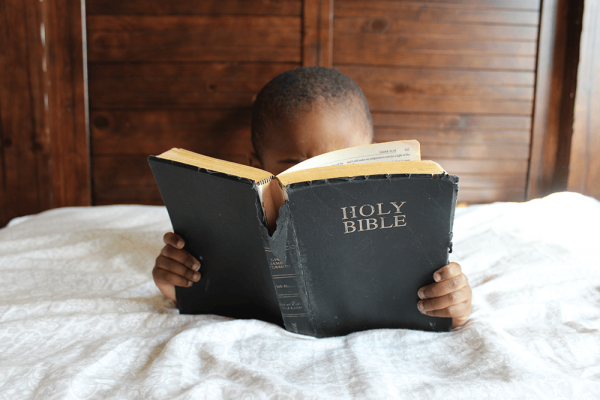Joshua was one of the star students in his Sunday school class at a Black Baptist church he and his family attended; his teacher raved about Joshua’s helpfulness and engagement. But when it came to preschool, Joshua’s parents were perplexed.
“Every day the preschool teacher has something negative to say about [him,]” Joshua’s father later told researchers.
Joshua’s mother, Gwendolyn Thompson McMillon, was in a doctoral program at Michigan State University at the time. She applied for a research grant and created a pilot study, examining her son’s experience with a researcher’s eye. In 2000, she and her colleagues published an article in the journal Language Arts titled “Why Does Joshua ‘Hate’ School ... but Love Sunday School?”
Thompson McMillon, who grew up in the Black church and studied literacy and language development, had a hunch that the environment of Sunday school — with its application-heavy storytelling and exchanging and reciting of prayer requests — was highly conducive to learning. In her research over the years, Thompson McMillon confirmed her hunch: Many Black Sunday schools were built on a centuries-old legacy of literacy education, and they were, well into the 21st century, succeeding where schools struggled or failed to engage and teach Black students.
“School is not going to turn into the Black church,” Thompson McMillon told Sojourners. So the question she asks is: “What can 21st century educators learn from the Black church?” In her ongoing qualitative research, she observes Sunday school environments through the lens of literacy education. Her research has demonstrated the contrast between the cultural and social environment in Black church’s Sunday school class and weekday school classrooms, and highlighted the cultural and social dynamics that contributed to reading and language development.
Her work builds on both history — the Black church was teaching people to read when enslavers prohibited it and continues to prioritize and celebrate Black culture in ways that white-led school systems do not — and research on language development. “[Historically, teaching literacy in Sunday school] had to happen, because that’s all we had,” Thompson McMillon said. “The church taught those foundational reading skills because there was no place else to go.”
Early literacy importance
The National Association for the Education of Young Children emphasizes the need for cultural competence when teaching young children to read. Reading is already complex — it requires children to connect symbols to sounds to meaning, and to do so in a way that their brains can hold onto one word long enough to connect it to the next word. If the cultural context of a story or lesson is always unfamiliar, the minoritized child has to work twice as hard to connect their lived experience to the classroom. It’s bad for literacy, education professional Ann McClain Terrell writes, and bad for their relationship to school. “...children of color do receive powerful messages when they do not find themselves reflected in the classroom learning materials and books they read.”
Thompson McMillon’s research found that Sunday school kids she knew were able to recite Bible stories verbatim, using the mature vocabulary of their teachers — two major indicators of developing language literacy. Many elementary aged children were able to explain the connection between the biblical concepts they were hearing and their life during the week.
Thompson McMillon, who grew up in Saginaw, Mich., in the 1960s and ’70s, remembered her mom asking kids how school was, and she remembers the tepid responses. Most kids didn’t really like school to begin with; for McMillion, school was also a reminder of all the things her family didn’t have, all the barriers between to their “success.” But in Sunday school, they were focused on the gifts God had given them and their community. They were celebrating and celebrated.
“As a young child growing up in what other people called poverty — they called it a bad neighborhood — I didn’t even realize that was the case because there were so many assets,” Thompson McMillon said. In the Black church environment, she said, generations of children — from the 18th century all the way up to present day — have come alive to a love of reading, learning, and communicative arts based on black church pedagogy, a term coined by Thompson McMillon to describe the past and present teaching and learning model used in the Black church.
Church learning model
“Within the Black church there’s the opportunity for multiple literacies,” said University of Houston assistant professor Monique T. Mills. A student can learn, for example, how to understand the diction of a King James Bible, the spiritual allusions of their pastor, and the subtleties of oration. From call and response during the sermon to the intensive discussion and application in Sunday school, she said, “There are opportunities for comprehension at a basic level, but also for enrichment [learning].”
Some of the magic of early literacy is baked into the church learning model. Thompson McMillon said oral language development and comprehension, as well as vocabulary building, happen naturally in a setting where a teacher’s main goal is to help kids apply biblical narratives to their lives, something that requires kids to understand the stories at a deeper level. Kids also participate in the main service, where they hear the communication between the pastor and the congregation. People are engaged, following along, and adding to the momentum of the narrative.
“That kind of energy and enthusiasm about oral language and development … those are authentic opportunities to develop oral skills,” Thompson McMillon said.
Mills said Black church Sunday school teachers have another advantage in their teaching because they share and value their students’ culture. When teachers and pastors know which local events, holiday traditions, and historical icons are most familiar, they can use that familiarity as a scaffold to help kids understand more challenging concepts and vocabulary.
In the past few decades, educators have put more emphasis on cultural competency, including early literacy, but many struggle to put it into practice. Cultural competency means more than just diverse books and toys in a preschool classroom, Mills explained. It’s about the teacher working toward a relationship with students. In a conventional setting where students must constantly overcome cultural differences to understand the illustrations and metaphors that are supposed to be helping them learn, they aren’t well served. When they have to change the way they speak in order to convince a teacher that they have absorbed content, they are working twice as hard. Teachers who understand their student’s culture are better able to use the tools of communication that support learning goals.
Thompson McMillon’s research on the Black church mirrors another finding by researchers who published the Black Child National Agenda, a 2021 report that found that at-home reading and storytelling was a prominent strength in Black families. The report used data from the National Center for Education Statistics and found that, “almost 8 out of 10 Black parents read to their children more than three times a week; tell a story; teach letters, words, and numbers; or engage in arts and crafts.” This is on par with Asian families, slightly lower than white families, and higher than Hispanic families. It demonstrates, the report suggests, that many of the infamous reading “gaps” schools continue to see are not based on a deficit in the home or community.
The formal learning environment continues to over-discipline Black students and offer lower-quality experiences in segregated and under-funded classrooms, compromising their learning experience, the report suggested. Thompson McMillon’s work suggests that at home and in community settings, like Sunday school, those barriers are gone.
In community-centered learning, Mills said, “You don’t assume that children don’t know anything.” Teachers instead connect to what the children know and use that to connect to new knowledge or encourage them to expand their exploration of a topic. The more the teacher understands what the child knows, the better they can build on and appreciate that knowledge. “That would allow children to feel comfortable learning, to feel joyful learning, to feel seen and heard.”
Thompson McMillon said that whole-person affirmation and empowerment is based on the values identified by Black liberation theology, which prioritizes meeting people’s needs. It connects social justice to the Bible in a way that affects a person’s lived experience and emphasizes building people up. Celebrating a child’s culture, empowering them through literacy, building on their strengths is a liberating contrast to a school system that treats their culture as a liability, focuses on learning gaps, and pushes them out of class when they don’t conform to expectations.
Black Sunday school teachers also found different methods to relate to a student who is too chatty or wiggly in class. Instead of the exclusionary discipline they might experience in school, a Sunday school teacher is more likely to give the child a job in the classroom with added responsibility such as assisting the teacher, or to have them sit closer to the teacher, Thompson McMillon observed, “to pull them in rather than push them out.”
The sense of belonging created in Sunday school can give students a support system all the way through college. Her church has a scholarship program and creates networks where kids can connect to opportunities. It gives them a “winning team” to be part of, and to cheer them on as they pursue their goals.
Because many families associate this sort of support with church, but not with school, Mills said, schools might be wise to consider churches as potential partners for certain kinds of outreach. Churches can be the kind of neutral sites for parent-teacher conferences, recommended by some experts. Bringing people into a place where they feel empowered is key to both parties being able to advocate for the child, to share their knowledge of a child’s strengths and weaknesses.
"The more that we can break down the walls around both the school and the church, the better off kids will be,” Mills said.
Got something to say about what you're reading? We value your feedback!







